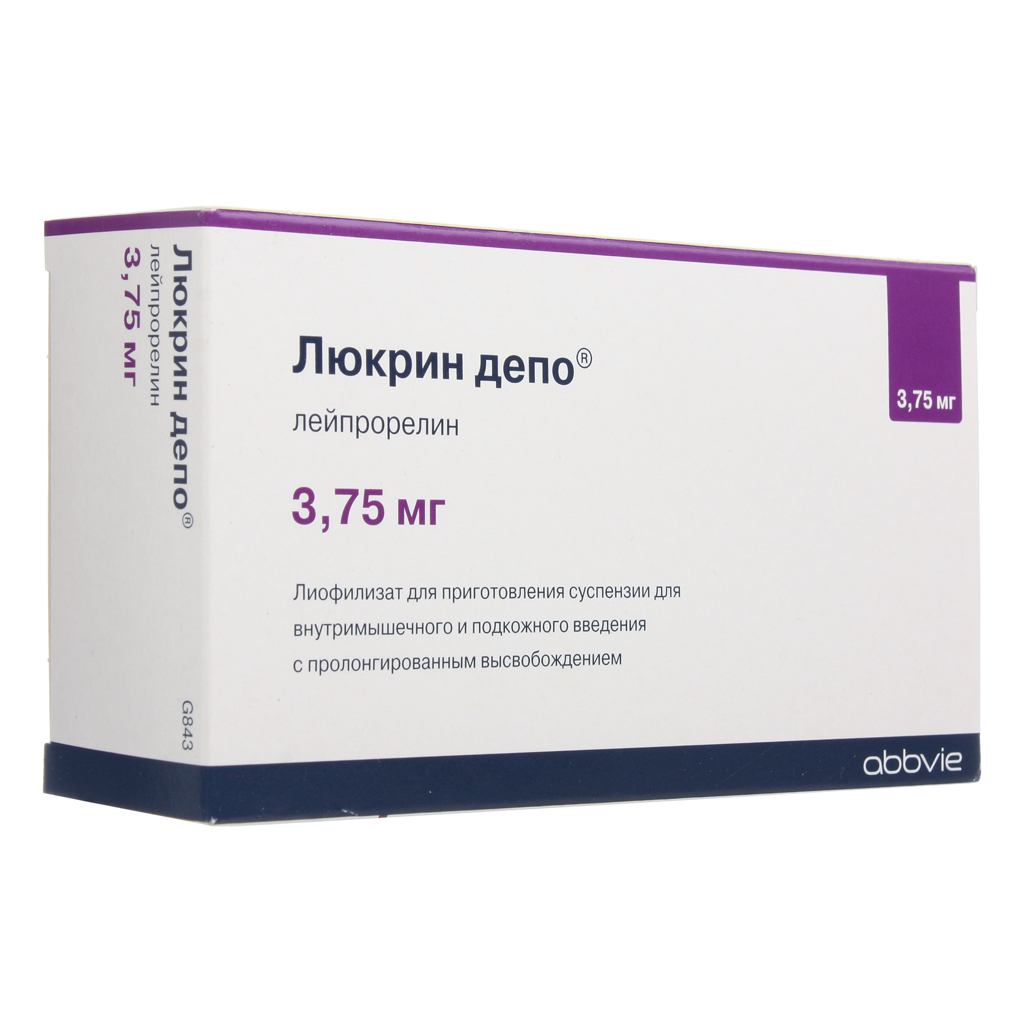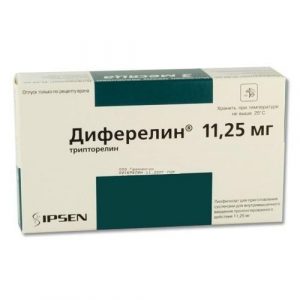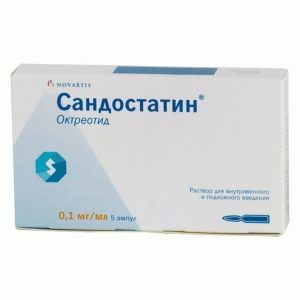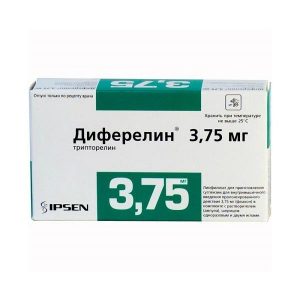Description
Latin name
LUCRIN DEPOT
Release form
Lyophilisate for the preparation of a suspension for intramuscular and subcutaneous administration of a prolonged action.
Packaging
In 9 ml clear glass bottles of 44.1 mg lyophilisate (complete with solvent – 2 ml ampoule with two blister packs with sterile needles and a disposable syringe with a napkin soaked in 70% isopropyl alcohol). In a cardboard box 1 set.
Pharmacological action of
Pharmacodynamics
Leuprorelin, a GnRH agonist, is an effective inhibitor of gonadotropin secretion with prolonged use in therapeutic doses. In humans, the administration of leuprorelin leads to an initial increase in the concentrations of LH and FSH, which leads to a transient increase in the concentrations of sex hormones (testosterone and dihydrotestosterone in men, estrone and estradiol in women). However, long-term administration of leuprorelin leads to a decrease in LH concentrations, FSH and sex hormones. In men, the concentration of testosterone decreases to a post-castration or prepubertal level. In women who are in a state before menopause, the concentration of estrogen drops to a postmenopausal level. These hormonal changes occur within a month from the start of drug therapy in recommended doses.
Suppression of steroidogenesis in the ovaries and testicles is a reversible process and ceases after the end of therapy.
Pharmacokinetics
The bioavailability of the drug when s / c and / m administration is comparable. The approximate value of the absolute bioavailability with the introduction of the drug at a dose of 7.5 mg is 90%.
After a single i / m and s / c administration of leuprorelin in patients with prostate cancer at doses of 3.75 and 7.5 mg, the average plasma concentrations of the drug at the end of the first month were 0, 7 and 1 ng / ml, respectively.
A serum concentration of 3.75 mg of leuprorelin was determined for 12 months. in 11 patients with premenopausal breast cancer. The average concentration of leuprorelin exceeded 0.1 ng / ml after 4 weeks and remained stable after repeated administration (at the 8th and 12th week). Cumulation of the drug was not observed.
Average Vss – 27 L Binding to plasma proteins – 43 49%. Systemic clearance – 7.6 l / h. T1 / 2 – about 3 hours. Leiprorelin, being a peptide, undergoes metabolic degradation, mainly peptidase, to shorter inactive peptides – pentapeptide (metabolite I), tripeptides (metabolites II and III) and dipeptide (metabolite IV). The time to reach Cmax of the main MI metabolite is 2 6 hours and corresponds to 6% of Cmax of leuprorelin. 1 week after injection, the average concentration of MI in the plasma is 20% of the average concentration of leuprorelin.
After administration of 3.75 mg of leuprorelin, the content of leuprorelin and MI in the urine was less than 5% of the administered dose 27 days after administration of the drug.
Pharmacokinetics in special clinical cases
The pharmacokinetics of the drug in patients with impaired liver or kidney function has not been investigated.
Indications
Progressive prostate cancer (palliative treatment), including when orchiectomy or estrogen treatment is not indicated or is not applicable in this patient
endometriosis (for a period of up to 6 months as the main therapy or an addition to surgical treatment)
uterine fibromyoma (for a period of up to 6 months as a preoperative preparation for removal of fibroids or hysterectomy, and also for symptomatic treatment and improvement in menopausal women who refuse surgery)
perimenopausal breast cancer in combination with
hormone therapy with precocious puberty (PPP) of central genesis.
Use during pregnancy and lactation
The drug is contraindicated in pregnancy and lactation, therefore, it is recommended to exclude the presence of pregnancy before using the drug.
Composition of
1 vial contains:
Active ingredient: leuprorelin acetate 3.75 mg.
Excipients: gelatin – 0.65 mg of lactic and glycolic acid copolymer – 33.1 mg mannitol – 6.6 mg.
Solvent (in ampoule): sodium carmellose – 10 mg mannitol – 100 mg polysorbate 80 – 2 mg water for injection – up to 2 ml.
Dosage and administration
IM or s / c, 1 time per month. The injection site should be changed periodically. A suspension for injection is prepared immediately before administration using the supplied solvent at a concentration of 3.75 mg / 1 ml.
For prostate or breast cancer, a single dose is 3.75 mg. The duration of treatment is determined by the doctor.
With endometriosis, uterine fibroids, a single dose is 3.75 mg.
For women of reproductive age, the first injection is carried out on the 3rd day of menstruation. The duration of treatment is not more than 6 months.
With PPP in children, the initial dose is 0.3 mg / kg (minimum 7.5 mg) once every 4 weeks.
The initial dose can be determined based on the child s body weight:
Child s body weight, kg
Dosage, mg
Number of syringes or bottles for injection
Total dose, mg
? 25
3.75
2
7.5 25
7.5 up to 37.5
3.75
3
11.25
> 37.5
3.75
4
15
Note: if 2 or more injections are necessary to obtain the desired total dose, they must be administered simultaneously.
Maintenance dose for PPP
If complete suppression of disease progression is not achieved, the dose should be increased every 4 weeks by 3.75 mg.
Withdrawal of the drug Lucrin Depot ® should be considered before reaching the age of 11 years in girls and 12 years in boys.
Instructions for preparing the suspension and injecting Lucrin Depot ® in vials:
1. Pour 1 ml of the solvent from the ampoule into the syringe with the needle in the kit and put it into the vial with lyophilisate (the remaining solvent should be disposed of).
2. Shake the vial well until a homogeneous suspension is obtained. The suspension becomes milky.
3. Immediately after dilution, fill the entire contents of the vial (or 2 vials) into a syringe (maximum 2 ml per syringe) and make a subcutaneous or intramuscular injection. Although the prepared suspension of Lucrin Depot ® remains stable for 24 hours after dilution, it should be used immediately after preparation. The remainder of the drug must be disposed of.
Instructions for injecting Lucrin Depot ® in dual-chamber syringes:
1. Screw the white piston into the end plug until the plug starts to rotate.
2. Hold the syringe upright. Introduce the solvent by slowly pressing (for 6 8 s) on the piston until the first plug is on the blue line in the middle of the syringe.
3. Continue to hold the syringe upright. With gentle shaking, mix the lyophilisate thoroughly with the solvent until a uniform suspension (suspension) is formed. The suspension becomes milky.
4. Hold the syringe upright. With the other hand, lift the needle cap up without unscrewing it.
5. Hold the syringe upright. Push the piston forward to remove air from the syringe.
6. Immediately after the formation of the suspension, immediately enter the entire contents of the syringe in / m or s / c, because the suspension settles very quickly.
Side effects of
From the CCC side: edema, angina pectoris, palpitations, bradycardia, tachycardia, arrhythmia, congestive heart failure, ECG changes, increased or decreased blood pressure, myocardial infarction, phlebitis, pulmonary embolism, stroke, thrombosis, trombosis phlebeurysm.
From the digestive system: change (increase, decreased or absent) appetite, changes in taste perception, dry mouth, thirst, dysphagia, nausea, vomiting, diarrhea or constipation, flatulence, increased or decreased body weight, impaired liver function, abnormal results of liver function tests, jaundice.
From the endocrine system: pain and sensitivity of the mammary glands, gynecomastia, lactation, enlarged thyroid gland, impotence, decreased libido, diabetes mellitus, androgen-like effects – virilization, acne, seborrhea, hirsutism, voice changes.
On the part of the blood and blood-forming organs: anemia, thrombocytopenia, leukopenia, leukocytosis, neutropenia, increased PV and partial thromboplastin time.
From the musculoskeletal system: bone pain, joint disorders, retroperitoneal fibrosis, arthralgia, myalgia, increased muscle tone, decreased bone density.
From the central and peripheral nervous system: headache, dizziness, fainting, sleep disturbance (insomnia), increased irritability, anxiety, pituitary apoplexy (in patients with pituitary adenoma), depression, paresthesia, memory impairment, hallucinations, hyperesthesia, hypesthesia, emotional lability, personality disorders, impaired neuromuscular transmission, peripheral neuropathy, drowsiness. Very rarely, cases of the occurrence of suicidal thoughts in patients and suicidal attempts were noted.
From the side of the respiratory system: cough, shortness of breath, nosebleeds, hemoptysis, pharyngitis, pleural effusion, fibrotic lesions in the lungs, lung infiltrates, respiratory distress.
From the skin and its appendages: dermatitis, dry skin, photosensitization reactions, skin itching, rash, erythema, urticaria, ecchymosis (skin hemorrhage), alopecia, pigmentation, striae, acne in women, changes in hairline formation (hair growth / loss).
On the part of the sensory organs: impaired vision and hearing, ringing in the ears, dry eyes, amblyopia.
From the genitourinary system: dysuria, dysmenorrhea, breakthrough and prolonged vaginal bleeding, dryness of the vaginal mucosa, vaginitis, odor from the vagina, leucorrhoea, pain in the prostate gland, testicular atrophy, pain in the testicles, hematuria, swelling of the penis. Changes in laboratory parameters: increased blood urea nitrogen, increased calcium, creatinine, bilirubin, uric acid hyperlipidemia (increased total cholesterol, LDL cholesterol, triglycerides), hyperphosphatemia, hypoglycemia, hyponatremia, hypoproteinemia, hypokalemia.
Local reactions: tissue tightening, hyperemia, inflammation and pain at the injection site.
Other: allergic reactions (including anaphylactic shock), flu-like syndrome, flushing of the face and upper chest, excessive sweating, swollen lymph nodes, chills, fever, lump in the throat, asthenia, dehydration.
Drug Interaction
Pharmacokinetic studies on the drug interaction of Lucrin depot ® with other drugs have not been performed. However, since leuprorelin is a substance of peptide nature and undergoes primary decay under the influence of peptidase rather than cytochrome P450 enzymes and about 46% of the drug binds to plasma proteins, drug interaction is unlikely.
overdose There are no data on the overdose of leuprorelin in humans. Administration of leuprorelin to patients with prostate cancer at a dose of up to 20 mg / day for 2 years did not cause the development of adverse events other than those observed with the drug at a dose of 1 mg / day.
In case of overdose, the patient should be prescribed symptomatic treatment.
Storage conditions
Store at 15 25 ° C. Do not freeze.
The Expiration of
is 3 years.
Deystvuyuschee substances
Leyprorelyn
Pharmacy
Pharmacy terms
Dosage form
ekarstvennaya form
suspension for injection




